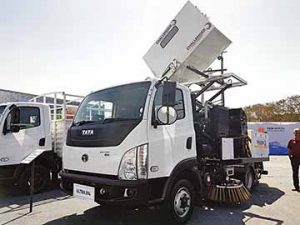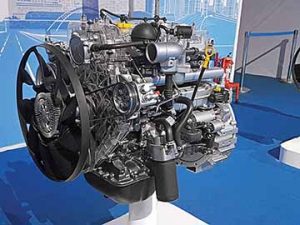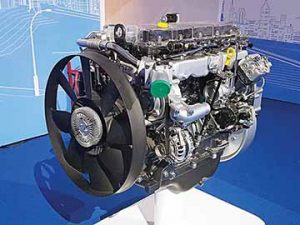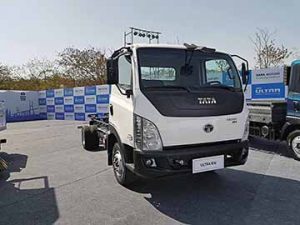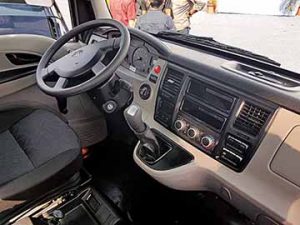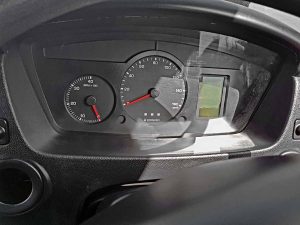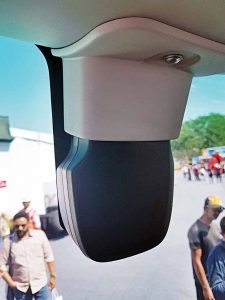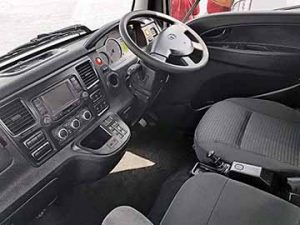The Ultra trucks that Tata Motors has launched, hint at a new trucking standard.
Story by:
Bhushan Mhapralkar
The two-wheeler carrier draws attention among the 13 Ultra trucks that Tata Motors has lined-up. With a GVW of 16,190 kg, the truck stretches beyond the intermediate segment. It almost ends up in the medium-duty segment. Fitted with a wider sleeper cabin, the two-wheeler carrier, based on the Ultra 1518, hints at how important the Ultra platform is to the company. Some 3000 units of the Ultra have been seeded already, and the feedback, according to Girish Wagh, Head – Commercial Vehicles, Tata Motors, is positive. Claimed to be the most significant CV platform after the Prima (World Truck Programme), the Ultra range of trucks, comprising 14 models in a GVW range of seven-tonnes to 16.2-tonnes, emphasise innovation according to Guenter Butschek, CEO and Managing Director, Tata Motors. Aiming at segments that clocked 85000 units in FY2016-17, and grew to 105,000 units in FY2017-18, the Ultra range of trucks, according to Butschek, will prove to be a disruptive force in the market.
Aiming at no less than 50 applications including two-wheeler carriage, cement, poultry, e-commerce, construction, agricultural supply chain, diverse municipal applications and more, the ability of the Ultra trucks to adapt to the application need should prove advantageous. Stating that they are about class-leading TCO, modular approach and customisation, Butschek expressed, “The Ultra trucks are a result of extensive customer feedback.” Priced between Rs.10 lakh and Rs. 25 lakhs, the Ultra range of trucks, according to Wagh, is about convenience, performance and comfort, and will address the changing needs of end users, fleet owners and drivers through superior earning potential, low cost of ownership and timely delivery of goods. Arriving in an environment where strong growth indicators are evident in the form of over six-lakh crore Rupees dedicated towards road development under the Gram Sadak Yojana, an exponential rise in e-commerce, and in the manufacturing sectors like cement, the Ultra range of trucks have been engineered to meet the changing requirements of customers.
Powered by a new 125 hp three-litre, and a 210 hp five-litre Turbrotron common-rail turbo-diesel engine with EGR exhaust aftertreatment system, the Ultra range boasts of a modern design. The cabins (there are three types – day, wide and sleeper) not only lend a dash of style to the Ultra with their aerodynamic stance, and clear lens headlamps, they also help meet the world (European safety) standards and some of the future requirements as well. Looking modern and ergonomically well-arranged, the cabins, on the inside, offer benchmark levels of visibility, safety and driving comfort. The walk-through cabins offer sufficient storage capacity and a provision to fit various accessories. Hinting at attention to detail, given the ability of the truck range, albeit with different drive orientation, to forward the interest of Tata Motors in overseas markets, the Ultra truck range has entered the market against a backdrop where the I&LCV segments are poised for big growth. Said Wagh, “The rise of 3PL logistics, rated payload regime and smart cities are set to put the ILCV segments on a fast growth track.” He drew attention to the growth in the market share of Tata ILCVs at 23 per cent, bucking the trend of last two years.
Offering benchmark levels of visibility, safety and driving comfort, the cabins of the Ultra range not only hint at high levels of modularity built into the platform but also at how modern and smart the truck range on the whole is. Either cabin of the Ultra offers sufficient storage capacity and provision for the fitment of various accessories. The cabin of the Ultra 1518 Plus, for example, comes with a sleeper bunk. The (narrow) day cabin of the T.7 provides enough space for up to three people to sit comfortably. Hydraulically tiltable (up to 45-degree) to gain access to the mechanicals underneath, the cabins of the Ultra truck range are designed to offer fatigue-free driving for longer intervals. The modern dash finished in a shade of black comes as a pleasant change. Not only does the dash with the gear shifter jutting out of the central console make for a car-like ambience, it marks a distinct change as far as truck cabins are concerned in terms of convenience, comfort and ergonomics. Capable of meeting global trucking standards in terms of emissions, safety and features – tested and homologated into various geographies (like South Africa, Malaysia, Philippines, Indonesia and other markets) outside India, the Ultra range of trucks promise to deliver superior performance, superior payload, superior mileage and significant productivity gains apart from the lowest cost of ownership.
The wheel size of the Ultra truck range varies (22.5 inch dia. for the two-wheeler carrier, 20 inch dia. for the 1518 tipper, and 17.5 inch dia. for the Ultra T.7) according to the dimensions, performance and payload capacity. The emphasis on modularity quite evident, the wheelbase across variants measures 3.3 m to 6.8 m. The truck could be had with either a five-speed manual transmission, a six-speed manual transmission or an automated manual transmission. In the (T.7) variant fitted with an automated manual transmission, the controls are in the form of buttons that are located at the same place where the gear shifter of the manual version is located on the centre console. Modularity also shows through the cabin width, which differs from variant to variant. The cabin width ranges from 1.9 m to 21 m. Engineered to address the changing needs of end users, fleet owners and drivers through superior earning potential, low cost of operation, and timely delivery of goods according to Wagh, the Ultra range of trucks reflect at a disruptive strategy at play. It is based on innovative products no doubt, but the fact is, much attention has also gone into ensuring high reliability.
Aiming at a market that clocked 85,000 units in FY2016-17, and grew to 105,000 units in FY2017-18, the Ultra range of trucks have been cleverly structured at certain stages such that the 10.3-tonnes payload model overlaps into the next segment. Offering higher tonnage potential at every tonnage point according to Girish, the Ultra range of trucks are expected to help Tata Motors to maintain traction in the ILCV segments by clocking higher growth than the industry average. Clocking a growth of 37 per cent against the industry growth of 25 per cent, the Ultra range of trucks are made at the same plant in Pune where the legendary Tata 407 LCV began production in the early 80s. According to Wagh, the Tata 407 created a completely new segment and revolutionised trucking in India. “Made at the same location, the Ultra marks a significant step forward,” he mentioned. Quite modular in nature, and backed by three-lakh and three-year warranty, the Ultra range of trucks offer longer deck lengths and higher payload capacities. If these properties hint at setting a trend, the Ultra trucks, according to Bustchek, are a trendsetter. They are backed by a guarantee of breakdown assistance in four hours. A result of an investment of Rs.1500 crores over the last few years, and which will go up according to Girish, the Ultra truck range is well poised to tap the trend of higher tonnage shift. With the shift to higher tonnage expected to continue across segments, and as the road network improves influencing a positive change in uptime and faster turnaround, the four or five key product lines of Tata Motors now includes the Ultra. Set to help the CV maker to retain an edge over competition, the Ultra range of trucks ride on the performance of Tata Motors, which recorded a 2.7 per cent gain in FY2017-18. Had in the form of alternate fuels too (the Ultra 1412 LNG is powered by a 120 hp engine mated to a five-speed gearbox), the Ultra range points at a definitive disruptive strategy at work. Equipped with power steering and parabolic leaf spring suspension at front, the Ultra range of trucks, said Bustchek, signal the future of trucking. Drawing attention to extensive customer feedback seeked from operators of the seeded units, he said, “We are on our toes to keep the tide on our side; to surprise the competition.” An example of how Tata Motors is working to keep the tide on its side is had in the form of the two Turbotron engines that power the Ultra range of trucks. One is a DOHC and the other is a SOHC. Capable of being scaled up to EuroVI emission regulations, the two Turbotron engines point at how Tata Motors is making an effort to address the changing requirements of the operators as well as the end users in terms of carrying capacity, uptime and faster turnaround. Also pointing at the change in power to weight ratio in-line with the tightening emission regulations and the resultant application of technology, the two Turbotron engines, point at rising quality consciousness among CV OEMs. Elements like fit and finish too. The aggregates that make the Ultra (Meritor axles, WABCO braking system, etc.) mark a significant step forward. Considering the efforts and resources that have gone into the development of the Ultra truck range, it will be interesting to see how soon, or the manner in which it influences a change in market dynamics in the ILCV segments.




